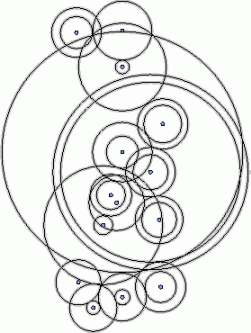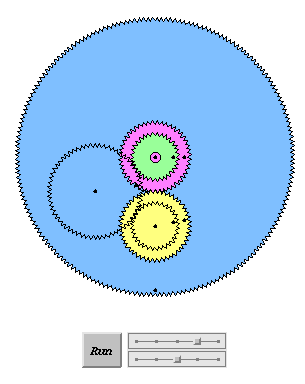| | 4. The differential in the Antikythera Mechanism  
The differential gear assembly in the Antikythera Mechanism. Most differentials are three-dimensional, using bevel gears to connect the two coaxial gears to the pinions. The Antikythera Mechanism incorporates an ingenious planar differential. The blue output gear carries the pinion, just as in modern differentials. The topological problem of having two coaxial planar gears meshing at the same rate with a third is solved by having a two-tier pinion. The larger gear on the pinion is the same size as the larger of the coaxial gears (here, purple); the smaller is the same size as the smaller coaxial gear (here, green). (In fact the size of the pinion is immaterial to the functioning of the differential, just as in the straight-line and elementary rotary versions; only the ratio of the two pinion gears must be the same as the ratio of the two coaxials.) The green gear and the pinion mesh via an "idler" gear, shown as transparent in the gearing diagram above. The idler allows the purple and green gears to contribute opposite rotations to the pinion. This is how the straight-line differential worked: the upper rack turned the pinion clockwise, while the lower rack turned it counterclockwise. So the same relation will hold between the speeds of the purple, green and blue gears: blue is one-half of the sum of purple and green.Two-tier pinions are used in a "latest generation" differential manufactured by Andantex Inc. The differential was built into the the Antikythera mechanism so as to subtract the rotation of the Sun from the rotation of the Moon. This is why it was convenient to have the sun-gear turning in the opposite direction from the sun's motion (see last month): the output of the differential will be one-half of the difference between the Moon's motion and the Sun's. This is exactly (one half) the rate of change of the phase of the Moon, since during the month the phase of the Moon (new, first-quarter, full, last quarter, ...) indicates exactly its relative position in the sky with respect to the sun. The gear train which appears just below the differential in the gear plan meshes with the blue gear and has as as one of its outputs this relative motion multiplied by a factor of two; this would give a gear which performed exactly one rotation in a synodical month, the time for a full cycle of the Moon's phases. This gear may have been used to turn a dial or an indicator to show the phase of the Moon. Unfortunately the dials on the back of the Antikythera Mechanism, where this information would have been displayed, are gone. |









